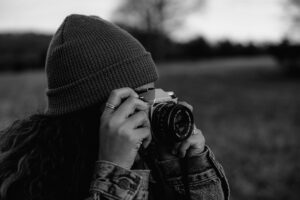If you’re trying to find the best camera for photography or video, you’re not alone. Whether you’re looking for a beginner camera, a mirrorless upgrade, or something lightweight for travel, this guide breaks down everything you need to know based on how you actually plan to use your camera.
Keep in mind that this post won’t recommend specific camera models or brands. But it will give you the right filters to apply when narrowing down your options.
TL;DR
- Start with your use case: Are you shooting portraits, landscapes, action, or videos? Your needs shape the right camera.
- Everyday or travel use? Choose compact, lightweight options with good zoom range and battery life.
- New to photography? Look for beginner-friendly cameras with guided modes or smartphone-style menus.
- Want cinematic portraits? Prioritize lens quality, large sensors, and low f-stop compatibility.
- Action/wildlife shooters: You’ll need fast autofocus, high burst rates, and long lenses.
- On a budget? There are great entry-level DSLR and mirrorless options under $1000.
- Video creators & vloggers: Flip-out screens, good audio input, and in-body stabilization are essential.
This post is just one part of my “Camera Buying Guide“, which you can download as a pdf file right now.
1. Best Camera for Everyday Use: Family Photos & Travel
If your main goal is to capture everyday life -family gatherings, vacations, weekend outings- then a compact camera is a great option. These are lightweight, easy to carry, and designed for convenience. Image quality is usually more than enough for photo albums, Instagram, and social media.
Most compact cameras offer full auto shooting modes, so you don’t have to worry about settings. They’re also small enough to fit in a bag or even a jacket pocket, making them perfect for casual photographers.
However, performance in low light tends to be weaker in this category. If you’re even slightly curious about getting deeper into photography later on, you might consider a high-end compact or entry-level mirrorless camera, though prices can quickly approach that of professional models.
Love taking selfies? Look for a camera with a tilting or fully articulating screen.
2. Choosing Your First Camera as a Beginner Photographer
Many people want to learn photography and start creating images like the pros, but they’re unsure where that path will lead. Will it remain a hobby? Will you start sharing your work online, or turn it into a freelance business one day?
If you’re in this exploratory stage, the best beginner camera is often a crop-sensor camera (also known as APS-C format). These cameras offer most of the features of full-frame models, but at a lower cost.
They’re perfect for learning the craft, building experience, and gradually improving image quality with new lenses. Some of the most popular models in this category have even been used professionally.
And when you’re ready to upgrade, it won’t be a huge leap. You’ll already own lenses and gear that can carry over to a better camera body later. Just be mindful of compatibility when buying accessories.
3. Top Cameras for Portrait Photography – Studio & Outdoor
If your main focus is portrait photography and you’re planning to shoot professionally -whether in a studio or outdoors- it’s worth investing in a full-frame camera from the start. These cameras provide better depth of field control, cleaner images in low light, and more flexibility with lenses.
In portrait work, your camera is only part of the equation. Studio lights and modifiers also play a big role, and we’ll cover those in a separate guide soon. Still, a solid full-frame body with one or two good lenses is enough to start your portrait business with confidence.
4. Best Street and Documentary Photography Cameras
For street photography or photojournalism, a smaller and more discreet camera is usually better. You don’t want to attract too much attention while shooting in public.
In this case, look into compact or mirrorless cameras with fast autofocus and decent continuous shooting speeds. Lightweight, quiet, and responsive cameras are key to working quickly and naturally on the street.
5. Landscape Photography Cameras for Capturing Nature
If your goal is to sell large prints of landscape or nature photography, you should prioritize high-resolution full-frame cameras. These allow you to capture more detail, crop if needed, and produce large-format prints without losing image quality.
6. High-Speed Cameras for Sports, Wildlife & Action Photography
Interested in photographing fast-moving subjects like athletes or wildlife? You’ll need a camera with high burst shooting speed, one that can take multiple frames per second when you hold the shutter down.
A fast, reliable full-frame camera with strong autofocus and buffer performance is ideal for these situations. Look for specs like at least 12-15 frames per second continuous shooting if this is your niche.
If you’re not sure what each camera spec means, check out our guide to camera specifications explained before deciding.
7. Best Vlogging Cameras for YouTube and Social Creators
If you’re planning to record videos of yourself -like for a YouTube channel or vlog- look for a mirrorless camera with a smaller body, and pay close attention to the LCD screen design. A flip-out or tilting screen is extremely helpful for self-recording, as it lets you see the composition and yourself while filming.
If the camera you’re considering doesn’t have an articulating screen, make sure it supports Wi-Fi or Bluetooth connection to a smartphone. Many apps allow you to use your phone as a live monitor and remote control. That feature can be a game-changer when you’re filming solo.
Reliable autofocus with eye tracking is also a great option to have for vloggers.
8. Best Hybrid Cameras for Video and Photography
If you’re planning to shoot lots of videos in addition to taking photos, look for a mirrorless camera (preferably full-frame) that offers 4K video recording at 60 frames per second (fps) or more. It should also support 24 fps, which is ideal for cinematic-style videos.
Mirrorless cameras have made huge improvements in autofocus for video, especially recent models. They’re a fantastic choice for hybrid shooters. So if you fall into this category, I wouldn’t recommend a DSLR.
9. Top Cameras for Creating Social Media Content
These days, many people buy cameras not for traditional photography, but for creating content for platforms like Instagram, YouTube, TikTok, or even LinkedIn. This kind of work blends photography and videography, and requires a camera that’s versatile, lightweight, and reliable.
If that’s your main use case, look for a camera with:
- Fast and accurate autofocus (especially eye and face tracking)
- A fully articulating LCD screen so you can see yourself while recording
- Good video quality (ideally 4K with 24, 30, and 60 fps options)
- A microphone input for better audio
- Built-in Wi-Fi or Bluetooth for quick file transfers to your phone
In-body or lens-based stabilization is also very helpful for handheld shooting.
10. Low-Light Cameras for Night Photography and Indoor Use
If you’re interested in night photography, stargazing, street shots, concerts, or any other low-light scenes, you need a camera that performs well in dark environments. High ISO performance and shadow detail retention are key.
For this, look for:
- A larger sensor (preferably full-frame) for better light-gathering
- Lenses with wide apertures (e.g., f/1.8 or f/1.4) to allow more light in
- In-body image stabilization (IBIS) for sharper handheld shots
- Long exposure options like Bulb mode or manual shutter control for astrophotography
Low-light performance makes a huge difference in both stills and video, so don’t overlook it, especially if you plan to shoot in available light without extra gear.
11. Lightweight Cameras for Everyday and Travel Photography
If you’re looking for something small and light that you can carry with you everywhere, consider compact cameras or action cameras.
Some of the latest action camera models are incredibly compact and offer impressive performance. In terms of video quality, these small devices can even compete with larger, more expensive systems. The main limitation is in still photography: the resolution often caps around 12MP.
However, newer models with RAW photo capabilities offer more flexibility in post-processing, helping you get better results even from smaller sensors.
Compact cameras also come in a variety of designs and have grown in popularity in recent years, especially among travelers and content creators. They’re easy to use and carry around.
Want to know more about RAW? check out our guide on RAW format in photography and video.
12. Best Solo Creator Cameras for Content on the Go
If you travel often or work solo as a vlogger, blogger, or freelancer, your camera needs to be both compact and dependable. In addition to being lightweight, it should offer solid build quality, USB-C charging, and wireless features.
For this kind of use:
- Mirrorless cameras with small lenses are ideal
- USB-C ports for direct charging via power bank are a big plus
- Weather sealing is important if you shoot outdoors or in unpredictable conditions
- A hybrid camera that does photo, video, and vlogging equally well is your best bet
If you’re often on the move or working alone, convenience, durability, and ease of use matter just as much as image quality.
13. Best Budget Cameras for Photography Beginners
Some people think photography is a hobby for the wealthy, but that doesn’t have to be true. If you’re on a budget (like I was when I started), you can absolutely get started without breaking the bank.
Your best bet is a crop-sensor DSLR paired with a good kit lens. Alternatively, you can buy just the camera body and choose your first lens separately. That first lens matters a lot. It can serve you well for years and reduce the need to buy more lenses right away.
Another option is a high-quality compact camera that supports RAW shooting. While the lens on these cameras isn’t interchangeable, if you learn to use it properly, you can still take excellent, high-quality photos. Trust me, no one will notice or care what camera you used if the results look good.
If you plan to work solo, our one-man studio setup guide covers what’s worth investing in.
14. Easy Point-and-Shoot Cameras for Simple Photography
Let’s be honest, not everyone wants to learn photography. If you’re someone who just wants to point the camera, press the shutter, and capture the moment -without diving into technical settings- then don’t overthink it. Just buy a good compact camera and enjoy taking pictures.
That said, if there’s even a small chance you’ll want to learn photography more seriously later, consider spending a little more on an advanced compact model. These usually offer manual controls and better image quality, giving you room to grow without needing to upgrade right away.
Reminder: This post is just one part of my “Camera Buying Guide“, which you can download as a pdf file right now.
Final Words
The best camera isn’t the one with the longest spec sheet, it’s the one that fits your goals, your workflow, and your life. Whether you’re chasing perfect sunsets, filming your next vlog, or capturing everyday moments with your family, starting with how you actually use your camera will always lead you to a better buying decision. And remember: great photos come more from the person behind the lens than the gear in front of it. Let this guide help you make a smart, confident choice.
FAQ
What’s the first thing to consider when choosing a camera?
Start by thinking about how you plan to use it -whether for portraits, landscapes, wildlife, or video- so you can prioritize the right features.
Do beginners need a full-frame camera?
Not necessarily. APS-C (crop sensor) cameras are more affordable, still excellent quality, and easier to grow with over time.
What features matter most for vlogging?
Look for a camera with a flip-out screen, good stabilization, audio input, and reliable autofocus, especially eye tracking if you’re filming yourself.




